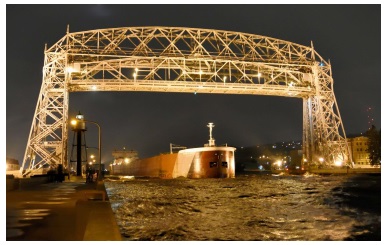
First outbound Laker of 2016 - the Edwin H. Gott - leaving Port of Duluth-Superior at 4:03 am on Tuesday, March 22. Duluth's famed Aerial Lift Bridge is visible as the vessel departs thru the Duluth Ship Canal.
Photo/Paul Scinocca
"The St. Lawrence River is a complex environment, so having fast, direct access to the environmental conditions happening there is mission-critical for all users," said Daniel Dagenais, the port authority’s vice-president, operations. "Such integrated, user-friendly accessibility to water level data was a key component of the web portal project, which benefits marine clients and supports port operations. That's why this improved app will be available through a link right on the home page of the Port of Montreal's website."
Seaway Opens 58th Navigation Season Ice Free and Two Weeks Earlier
The U.S. and Canadian Seaway Corporations marked the opening of the Seaway’s 58th navigation season on March 21, with the transit of Canada Steamship Lines’ Thunder Bay through Lock 3 on the Welland Canal. The ship, carrying a load of road salt, will be replenishing stocks depleted by ice storms which repeatedly struck Eastern Canada during the winter.
"The Great Lakes St. Lawrence Seaway System continues to be an environmentally sustainable, vital route for commerce in the global supply chain," said Betty Sutton, administrator of the U.S. Saint Lawrence Seaway Development Corporation (SLSDC). "The Great Lakes region, North America’s ‘Opportunity Belt’ is a thriving and influential destination and the Seaway System connects this region to the world. Businesses are choosing to move their cargo through the Seaway System because of the economic benefits, safety, and reliability of our waterway, and its direct access to the heartland of North America."
"The ongoing investment in new vessels by a variety of Seaway carriers underscores our customers’ faith in the future of the waterway," said Terence Bowles, president and CEO of The St. Lawrence Seaway Management Corporation (SLSMC). "In parallel with our customers’ investments, the Seaway’s award winning modernization program is now well-over 50 percent complete, with Hands-Free Mooring operational at eight of the Seaway’s locks. We are making steady progress in bringing about gains in efficiency and safety for all concerned, ensuring a highly competitive transportation system for years to come."
K S Windsor Salt ships the majority of the production from its Ojibway Mine in Windsor via the Great Lakes/Seaway System. Francois Allard, Director Marine Distribution for K S Windsor Salt Ltd., said, "Not only is the Seaway transportation system the most cost-effective way to reach our markets, it also minimizes our impact on the environment. The Thunder Bay’s transit from the Ojibway mine to Bowmanville takes almost 1,000 truckloads off Ontario highways. It’s important that all levels of government continue to invest in infrastructure along this waterway and we applaud the modernization of the lock system."
For more information on the St. Lawrence Seaway visit www.greatlakes-seaway.com website.
2016 Commercial Shipping Season gets underway in Port of Duluth-Superior
Two U.S.-flag lakers departed the Port of Duluth-Superior, Tuesday, March 22, signaling the start of the 2016 commercial shipping season at this, the farthest inland port on the Great Lakes St. Lawrence Seaway (GLSLS) system.
The Edwin H. Gott moved from its winter berth at the Clure Public Marine Terminal – first to fuel, then to depart beneath Duluth’s famed Aerial Bridge en route to the CN Dock in Two Harbors to load iron ore pellets. Shortly thereafter, another ship in the Great Lakes Fleet, the Philip R. Clark, also fueled and headed to Two Harbors. Both vessels, with deliveries to make to steel mills on the Lower Lakes, then proceeded across Lake Superior toward Sault Ste. Marie (MI) and transit via the Soo Locks, which opened at 12:01 a.m. on Friday, March 25.
The Paul R. Tregurtha, which spent winter layup at the Superior Midwest Energy Terminal, loaded coal there on Thursday, March 24, before departing that evening for the St. Clair Power Plant in Michigan. Two additional vessels that wintered over in the Twin Ports – the Kaye E. Barker and the American Century – are scheduled to depart later this month. The Herbert C. Jackson, which is undergoing a major repowering project at Fraser Shipyards, won’t sail until sea trials are completed in June.
The Soo Locks provide a pivotal gateway for lakers – some of which measure more than 1,000 feet in length – to move raw materials like iron ore, coal, limestone, cement and salt between Lake Superior and Lakes Michigan, Huron and Erie. It is one of a total of 16 sets of locks along the entire Great Lakes St. Lawrence Seaway that allow salties to move breakbulk and project cargoes in and out of North America’s heartland and deliver Midwestern grains to Europe, the Middle East and North Africa.
"Despite warm temps and virtually ice-free conditions across the Lakes, we couldn’t compensate for the downturn in iron ore last year. Sub-par growth in China coupled with the dumping of foreign steel into U.S. markets caused a commodity recession across the board. Those declines in production at mines and mills are reflected in overall 2015 tonnage for the Port of Duluth-Superior being off more than 12 percent last year," said Vanta Coda, Duluth Seaway Port Authority executive director.
"There are still some formidable challenges along the Great Lakes, but nowhere near what the fleets were facing last year," he added. "Our Congressional delegation led the charge in taking significant trade action in the past six months which has made huge inroads with unfair global trade practices. We all anticipate a slow start to the 2016 shipping season as headwinds still exist in commodity pricing, but the steel market and U.S. producers should begin to stabilize this year."

First outbound Laker of 2016 - the Edwin H. Gott - leaving Port of Duluth-Superior at 4:03 am on Tuesday, March 22. Duluth's famed Aerial Lift Bridge is visible as the vessel departs thru the Duluth Ship Canal.
Photo/Paul Scinocca